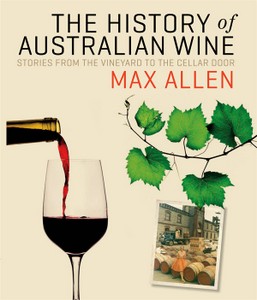|
Wine
book reviews
The history of
Australian wine: stories from the vineyard to the cellar door
Max Allen
Victory Books, Australia 2012
 Thereís
something interesting about history, and as you develop more of your
own, you tend to become more interested in it. For this reason, I
was really pleased to open a package containing a new book on the
history of Australian wine in the 20th century, written by Max
Allen. Thereís
something interesting about history, and as you develop more of your
own, you tend to become more interested in it. For this reason, I
was really pleased to open a package containing a new book on the
history of Australian wine in the 20th century, written by Max
Allen.
The book is based on an oral history
taken by Rob Linn, who spent a considerable amount of time
interviewing key figures in the industry. This research was funded
by the Wolf Blass Foundation, and Max Allen has drawn on this to
help write this book.
Itís a lovely looking book, in full
colour, and has plenty of photographs. They are one of the most
powerful aspects of the book, and two, in particular, stand out. The
first is on page 155, and itís a black and white shot of a
Penfolds board meeting in 1972. Four late-middle-aged men are
sitting round a table. The brylcreemed, moustachioed Max Schubert is
second right, and heís watching carefully as the chap to his right
is pouring a glass of what looks like either sherry or brandy. All
four are smoking and the ashtray on the table is full. Another era.
The other is a full-page colour picture
on page 9. Itís a beach scene from the 1960s. In the background,
out of focus, two men and a girl are enjoying the sun and sea. Even
though they are out of focused, you can just see that they are
smiling. Theyíre well tanned. In the foreground there are two
glasses and a bottle, in sharp focus, stuck into the sand. The
bottle shape indicates this is Riesling, and it looks very inviting.
The beach goers can be seen upside down in the lens created by the
glasses. Itís such a happy shot, but, again, a different era.
Australian wine has come a long way since
1900. It has changed almost beyond recognition, developing since the
1950s from an industry focused on fortifieds to one focused on table
wines. And from the 1980s onwards, the style of table wines has
shifted. The industry is currently in a period of flux, too.
Allen captures many of the transitions
very well. He paints pictures with his words, and the extensive
quotes from Linnís oral history help bring this work to life. Any
criticisms? Well, the pictures of Cloudy Bayís Marlborough
vineyard and an unnamed vineyard in St Estephe on pages 96 and 98
seem a bit of a waste: it would have been better to have some more
wonderful archival images than these, which are only distantly
related to the theme. And maybe there is one picture too many of
Wolf, but I guess he did fund the book in the first place, for which
he deserves a lot of credit.
Otherwise, itís a really engrossing
read, and thoroughly recommended.
Currently available in Australia from Random House. Will be
published in US and UK later this autumn.
To Buy:
 Back
to book review section Back
to book review section
 Older book reviews Older book reviews
Back
to top
|

